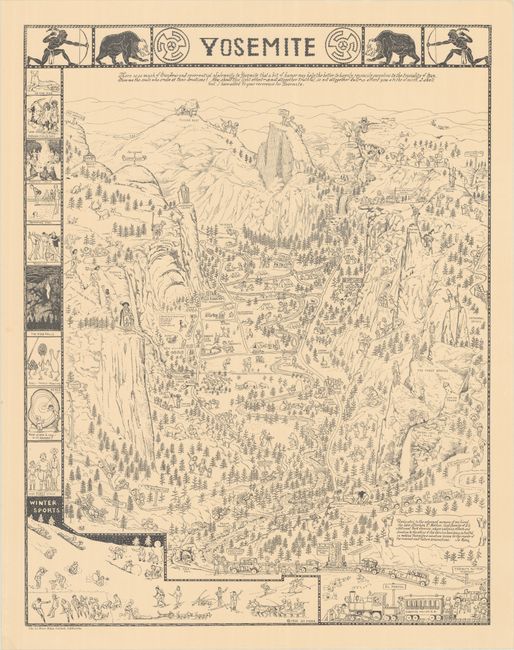Subject: Yosemite, California
Period: 1931 (dated)
Publication:
Color: Black & White
Size:
20.1 x 25.8 inches
51.1 x 65.5 cm
This is the first printed edition of Jo Mora's delightful pictorial map of Yosemite, printed in black & white and in a larger format than the later color editions. It is one of three maps he created showcasing American national parks. Dedicated to Mora's friend Stephen Mather, the industrialist and conservationist who became the first director of the National Park Service (an organization he rallied to create), the map depicts the majestic sweep of Yosemite National Park and is filled with light-hearted illustrations and visual puns. Perhaps the note beneath the title best sums up Mora's project: "There is so much of Grandeur and reverential Solemnity to Yosemite that a bit of humor may help the better to happily reconcile ourselves to the triviality of Man. Give me the souls who smile at their devotions! Now, should this light effort-- not altogether truthful, so not altogether dull-- afford you a tithe of mirth, I shall feel I have added to your reverence for Yosemite." Among the puns are a king atop Royal Arches, a picnic basket on Basket Dome, and a man relaxing in a chair, engulfed by a cloud on Cloud's Rest. The title is done in a style that emulates the Native American art for which Mora had such an appreciation. Several panels run down the left side of the map showing various activities available to tourists at the park, including an image of "That First View" (a family standing with their mouths agape) and a large vignette focused on winter sports. A fine example of the art of pictorial mapmaking. Imprint at bottom left reads "The Jo Mora Maps, Carmel, California."
Joseph ("Jo") Jacinto Mora was born in Uruguay in 1876 and moved the following year with his family to the eastern United States. He showed an early aptitude for the arts and began illustrating for newspapers and children's books in his twenties. Mora was fascinated with the American West, and after working on cattle ranches in Texas and Mexico as a young adult, he moved permanently out west in 1903. He spent his time learning about old Spanish vaqueros, American cowboys, and the Hopi and Navajo tribes, subjects which became lifelong passions and the focus of much of his work. His paintings and photographs of the Hopi were memorialized into a traveling exhibit for the Smithsonian Institution in 1979.
Mora was an artist with many talents, including drawing, painting, illustration, sculpture, photography, writing, and mapmaking. His artistic skills were perhaps unsurprising, as his father was a noted sculptor, and Jo Mora on occasion helped his father on sculpting commissions, including the facade of the Native Sons of the Golden West Building in San Francisco. His foray into mapmaking began later in his career while he was residing in Pebble Beach, California, where he would spend the last 27 years of his life. Mora's first map was of the Monterey Peninsula, entitled California's Playground, and was commissioned by the Del Monte Hotel to commemorate the hotel's grand reopening in 1926. The map combined historical facts with whimsical illustrations, cartographic points of interest, cartoonish figures, and witty notations. And thus was born Mora's unique style that is common on all of his "cartes," a term that he used for his cartographic works. Although Mora only created about a dozen maps in his career, Stephen J. Hornsby contends that "His maps formed the most important collection of pictorial cartography done by any artist of one particular region of the United States" (Hornsby, p. 29).
Provenance: collection of Peter Hiller. The map is accompanied by a letter of provenance signed by Hiller, Jo Mora Consultant and author of The Life and Times of Jo Mora: Iconic Artist of the American West.
References: Hornsby (Picturing America) pp. 28-31; Rumsey #8076.
Condition: A
A fine impression on a faintly but pleasantly toned sheet with minor creasing along the far edges of the sheet.


